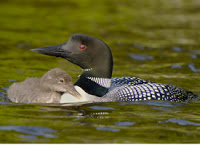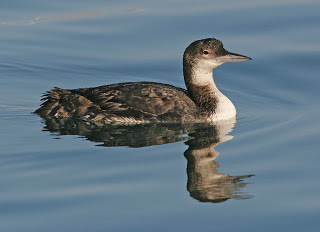By Shannon Junior, Aquatic Ecologist
Common Loon nonbreeding plumage
Most of us pay close attention to our ponds and lakes during the summer months. Whether we are fishing, boating, or simply walking the dog along the shoreline, it is usually during the warm part of the year that we spend time appreciating our aquatic resources. As the weather turns colder, most of us move indoors and enjoy our ponds from afar. While some of us do truly appreciate the simple beauty of an ice-covered pond, even if only admired from the window, there are many opportunities for winter excitement as well. There are certain species of waterfowl that can only be seen in our area during the winter, and your pond may be a stopping point along their journey.
Everyone is used to seeing Canada geese and mallard ducks – they are all over our ponds throughout the year. Maybe you have even been lucky enough to see a wood duck or a hooded merganser. Those birds live here year-round and breed in ponds in the mid-Atlantic. However, many ducks and geese are only temporary visitors to our area. Historically, migratory waterfowl relied on rivers and estuaries for aquatic habitat along their travel route. But with the widespread creation of inland recreational lakes and stormwater ponds, there are many more options for migration stopovers and wintering habitat to get the birds through the coldest, darkest days of the year. This gives us increased opportunities to view migratory waterfowl in our own backyards.
One such bird that most people are familiar with is the common loon. Although you would need to go pretty far north in the U.S. or up into Canada to see the birds in their gorgeous tuxedoed breeding plumage, they can be seen during migration throughout most of the country wearing their drabber non-breeding feathers. In winter, they have a gray patterned back with a plain white throat and chest, and even their bills fade to gray. They sit very low in the water, and frequently dive beneath the surface to hunt for fish. Because they need a long “runway” for takeoff, they are typically only found on larger water bodies. Loons are quite beautiful no matter when you see them, but it’s really their haunting song that makes them one of my favorite birds.

Common Loon breeding plumage
The snow goose is another bird that you might be lucky to spot during the winter. The birds are white with black wing tips, which are much more visible when they are in flight. While there is also a dark morph of the species, the white form is what is most commonly seen in our area. Snow geese form large flocks that can sometimes be seen in our area foraging in plowed cornfields and wetland habitats. They roost in ponds and lakes for safety, so keep an eye out for them early in the morning or later in the evening.
More experienced bird enthusiasts may even be able to pick out a cackling goose. Cackling geese look nearly identical to Canada geese, but they are smaller and have a proportionally smaller bill. To make it even more challenging to identify them, they are often found together in mixed flocks with the Canada geese. It is uncommon, but definitely not unheard of for these birds to be spotted in our area. My husband once spent over an hour looking through his telescope at a large flock of Canada geese, and was finally able to pick out the lone cackling goose that had been spotted in the flock by other birders. I will freely admit that my dedication waned after about 15 minutes, but it was pretty exciting to see when he pointed it out to me!
None of these birds are extremely common in our area, but you will definitely have a better chance of viewing them if your pond or lake is not completely frozen over. All of them rely on open water for hunting or foraging as well as for safe roosting areas away from predators. Ponds with floating fountains or aeration systems will not be able to freeze completely, which provides valuable winter habitat for migrating and overwintering waterfowl. Believe it or not, aeration is good for more than just water quality. Maybe the chance to view an unusual bird will encourage us to grab our binoculars and venture out of our warm living rooms to enjoy some winter excitement!
Contact the experts at 888-480-5253 for all of your lake, pond and fisheries management needs.
Shannon Junior is a Regional Manager and Aquatic Ecologist at SOLitude Lake Management. Since 1998, SOLitude Lake Management has been committed to providing full service lake and pond management services that improve water quality, preserve natural resources, and reduce our environmental footprint. Services are available throughout the Eastern United States. Fisheries management consulting and aquatic products are available nationwide. Learn more about SOLitude Lake Management and purchase products at www.solitudelakemanagement.com.











